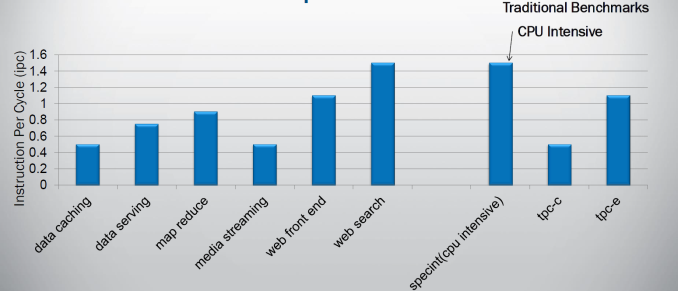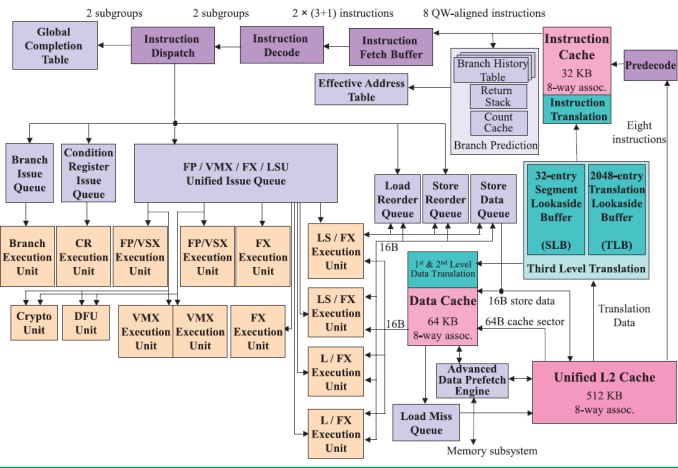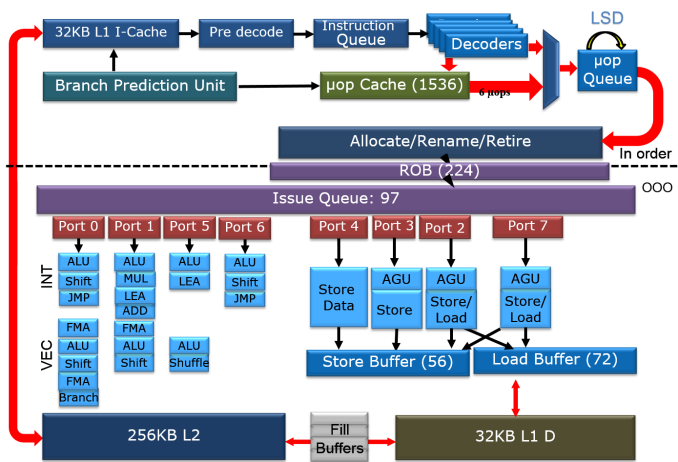Assessing IBM's POWER8, Part 1: A Low Level Look at Little Endian
by Johan De Gelas on July 21, 2016 8:45 AM ESTInside the Beast(s)
When the POWER8 was first launched, the specs were mind boggling. The processor could decode up to 8 instructions, issue 8 instructions, and execute up to 10 and all this at clockspeed up to 4.5 GHz. The POWER8 is thus an 8-way superscalar out of order processor. Now consider that
- The complexity of an architecture generally scales quadratically with the number of "ways" (hardware parallelism)
- Intel's most advanced architecture today - Skylake - is 5-way
and you know this is a bold move. If you superficially look at what kind of parallelism can be found in software, it starts to look like a suicidal move. Indeed on average, most modern CPU compute on average 2 instructions per clockcycle when running spam filtering (perlbench), video encoding (h264.ref) and protein sequence analyses (hmmer). Those are the SPEC CPU2006 integer benchmarks with the highest Instruction Per Clockcycle (IPC) rate. Server workloads are much worse: IPC of 0.8 and less are not an exception.
It is clear that simply widening a design will not bring good results, so IBM chose to run up to 8 threads simultaneously on their core. But running lots of threads is not without risk: you can end up with a throughput processor which delivers very poor performance in a wide range of applications that need that single threaded speed from time to time.
The picture below shows the wide superscalar architecture of the IBM POWER8. The image is taken from the white paper "IBM POWER8 processor core architecture", written by B. Shinharoy and many others.
The POWER8+ will have very similar microarchitecture. Since it might have to face a Skylake based Xeon, we thought it would be interesting to compare the POWER8 with both Haswell/Broadwell as Skylake.
The second picture is a very simplified architecture plan that we adapted from an older Intel Powerpoint presentation about the Haswell architecture, to show the current Skylake architecture. The adaptations were based on the latest Intel optimization manuals. The Intel diagram is much simpler than the POWER8's but that is simply because I was not as diligent as the people at IBM.
It is above our heads to compare the different branch prediction systems, but both Intel and IBM combine several different branch predictors to choose a branch. Both make use of a very large (16 K entries) global branch history table. Both processors scan 32 bytes in advance for branches. In case of IBM this is exactly 8 instructions. In case of Intel this is twice as much as it can fetch in one cycle (16 Bytes).
On the POWER8, data is fetched from the L2-cache and then predecoded into the L1-cache. Predecoding includes adding branch, exception, and grouping. This makes sure that predecoding is out the way before the actual computing ("Von Neuman Cycle") starts.
In Intel Haswell/Skylake, instructions are only predecoded after they are fetched. Predecoding performs macro-op fusion: fusing two x86 instructions together to save decode bandwidth. Intel's Skylake has 5 decoders and up to 5 µop instructions are sent down the pipelines. The current Xeon based upon Broadwell has 4 decoders and is limited to 4 instructions per clock. Those decoded instructions are sent into a µ-op cache, which can contain up to 1536 instructions (8-way), about 100 bits wide. The hitrate of the µop cache is estimated at 80-90% and up to 6 µops can be dispatched in that case. So in some situations, Skylake can run 6 instructions in parallel but as far as we understand it cannot sustain it all the time. Haswell/Broadwell are limited to 4. The µop cache can - most of the time - reduce the branch misprediction penalty from 19 to 14.
Back to the POWER8. Eight instructions are sent to the IBM POWER8 fetch buffer, where up 128 instructions can be held for two thread(s). A single thread can only use half of that buffer (64 instructions). This method of allocation gives each of two threads as much resources as one (i.e. no sharing), which is one of the key design philosophies for the POWER8 architecture.
Just like in the x86 world, the decoding unit breaks down the more complex RISC instructions into simpler internal instructions. Just like any modern Intel CPU, the opposite is also possible: the POWER8 is capable of fusing some combinations of 2 adjacent instructions into one instruction. Saving internal bandwidth and eliminating branches is one of the way this kind of fusion increases performances.
Contrary to the Intel's unified queue, the IBM POWER has 3 different issue queues: branch, condition register, and the "Load/Store/FP/Integer" queue. The first two can issue one instruction per clock, the latter can send off 8 instructions, for a combined total of 10 instructions per cycle. Intel's Haswell-Skylake cores can issue 8 µops per cycle. So both the POWER8 and Intel CPU have more than ample issue and execution resources for single threaded code. More than one thread is needed to really make use of all those resources.
Notice the difference in focus though. The Intel CPU has half of the load units (2), but each unit has twice the bandwidth (256 bit/cycle). The POWER8 has twice the amount of load units (4), but less bandwidth per unit (128 bit per cycle). Intel went for high AVX (HPC) performance, IBM's focus was on feeding 2 to 8 server threads. Just like the Intel units, the LSUs have Address Generation Units (AGUs). But contrary to Intel, the LSUs are also capable of doing simple integer calculations. That kind of massive integer crunching power would be a total waste on the Intel chip, but it is necessary if you want to run 8 threads on one core.













124 Comments
View All Comments
Kevin G - Tuesday, August 2, 2016 - link
"These oracle sparc m7 benchmarks vs IBM power8 are not worst case.">Eh? Did Oracle release the complete system configuration of the POWER8 for their testing? From your stream link you can find this PDF ( https://blogs.oracle.com/BestPerf/resource/stream/... ) where Oracle only test with 24 threads out of 96 possible in the environment and out of 192 possible supported with the hardware. This document does not detail how many cDIMMs were installed in a system which has a direct impact on available bandwidth. Case in point, the 512 GB of memory on the POWER8 system can be configured with the bare minimum number of cDIMMs in a system. That is a worst case scenario for POWER8 and we don't know if Oracle used it.
Oracle also made a source code change for STREAM for reverse allocation. The thing that is missing here is a comparison to the original code. This could impact how well prefetchers work and favor a particular architecture and thus impact performance. Thus we don't know if this change is a best or worst case scenario for comparison purposes.
"If you find other IBM power8 benchmarks I am sure oracle will compare to them instead. But you can only bench against ibm's own results, right?"
>I find it perfectly fair to use submitted benchmarks from IBM to compare against similarly configured systems submitted by Oracle. POWER8 systems are available with higher clocks and more cores than what is generally used in the open benchmarks IBM has submitted. Thus it is deceptive to claim that SPARC is decisively faster when there is beefier IBM hardware available.
"I am an sparc supporter. What is the problem with being an supporter?"
>Nothing inherently wrong with that but you are incredibly closed minded to any other alternative. You are blind to the idea that anything could be better or competitive in any metric. The reality of IT is that there no one tool that best fits every job. Anyone claiming otherwise is trying to sell you something.
"I would like anandtech to talk about the best CPU in the world instead of slow IBM power or Intel Xeon CPUs. But anandtech don't."
>How about you use your contacts at Oracle to get Anandtech a test system for some real independent analysis?
"I have never worked in IT."
>This explains a lot.
wingar - Saturday, July 23, 2016 - link
So, no one in the entire comment section mentioned SPARC at all. You come along, start ragging on POWER8, how SPARC is so much better, and then link to benchmarks on Oracle's website, with results provided by Oracle, with the conclusion of Oracle being so much better. Not only that, but the benchmarks you link require Oracle to use much higher end and incredibly higher cost hardware to beat low and mid-range POWER8 with.On top of all that you make dubious and unsubstantiated claims about server workloads and claims of performance of POWER8 and x86.
And finally to top it off, your comment is barely even related to the comment you replied to. It seems you picked the comment most visible in the thread to reply to.
So, to everyone else I think it's quite clear this is just an Oracle shill, please just ignore him.
wingar - Saturday, July 23, 2016 - link
So, adding on to this I was curious. I decided to make a simple google search, "site:anandtech.com brutalizer". What did I find? Comments on anything x86 and POWER8, every single one talking about how Oracle and SPARC are so much better than whatever the review is talking about. Consistently linking to Oracle-ran benchmarks on Oracles own site with the conclusion that Oracle is better. Consistently making dubious claims about the non-Oracle hardware. Every single comment I found shilling for SPARC, and every single one as close to the top of the comments list as possible. You seem to want to be as visible as possible.Have some links.
http://www.anandtech.com/comments/10158/the-intel-...
http://www.anandtech.com/comments/9193/the-xeon-e7...
http://www.anandtech.com/comments/10230/ibm-nvidia...
http://www.anandtech.com/comments/9567/the-power-8...
http://www.anandtech.com/comments/7757/quad-ivy-br...
http://www.anandtech.com/comments/7852/intel-xeon-...
http://www.anandtech.com/comments/7285/intel-xeon-...
Infact I found a couple of comments you left that *weren't* shilling. Have some links.
http://www.anandtech.com/comments/7334/a-look-at-a...
http://www.anandtech.com/comments/7371/understandi...
http://www.anandtech.com/comments/5831/amd-trinity...
It's hard to draw a conclusion from those two links but I'll point a few things. All of the non-shilling comments you made were in 2013. Every single pro-Oracle comment you made was at minimum 2014. Sounds to me like you were either bought out at that time, or you bought someone else's account, or perhaps this was the time you were put on Oracle's pay-cheque. It's quite possible that there's more comments that aren't shilling that I've missed here.
So, please. Try again.
Zetbo - Saturday, July 23, 2016 - link
He is a known Oracle Troll/Shill Kebbabert who is probably paid by Oracle to post crap all over internet. If he is not paid then thats just sad...wingar - Saturday, July 23, 2016 - link
Ohhh yes I am well aware, I encounter him on El Reg and other places all the time. But hey, I hate shills, so I'm quite happy to destroy any sense of credibility he may have for those not in the know.tipoo - Tuesday, July 26, 2016 - link
Ooh, good callout. It would almost be weirder if Oracle *didn't* pay him after all those links, lol.Kevin G - Wednesday, July 27, 2016 - link
Here is an interview with him (in Swedish) about how he was invited by then Sun to a party for his efforts:http://it24.idg.se/2.2275/1.202161/staende-ovation...
wingar - Thursday, July 28, 2016 - link
I'd call it sad, really. Very sad.alpha754293 - Wednesday, July 27, 2016 - link
Dude, SPARC sucks.Look at SWaP and TCO. Re-run your "analysis", it's obvious that SPARC sucks.
Can you even RUN Ubuntu on SPARC anymore?
Their FP performance sucks and it always have. That's why The Niagara T2 had to have FPUs ADDED to ALL of the cores because sharing a single FPU with 8 cores was a really bad/dumb idea.
I've looked at SPARC before. Had a couple of them and had a SunFire server before as well, and POWER/Intels can easily beat SPARC, especially once you consider TCO.
The company that I work for now (a Fortune 10 company) dumped all of the SPARC workstations for Intel.
RISC is RISKY! - Tuesday, August 2, 2016 - link
I would support "Brutalizer". Every processor has its strength and weakness. If memory architecture is considered, for the same capacity, Intel is conjested memory, IBM is very distributed and Oracle-Sun is something in between. So Intel will always have memory B/W problem every way. IBM has memory efficiency problem. Oracle in theory doesn't have problem, but with 2 dimm per ch, that look like have problem. Oracle-Sun is for highly branched workload in the real world. Intel is for 1T/Core more of single threaded workloads and IBM is for mixed workloads with 2T-4T/Core priority. So supercomputing workloads will work fast on IBM now, compared to intel and sparc, while analytics and graph and other distributed will work faster on SPARC M7 and S7 (although S7 is resource limited). While for intel, a soft mix of applications and highly customized os is better. Leave the business decisions and the sales price. List prices are twice as much as sales price in the real world. These three processors (xeon e5v4, power8-9, sparc m7-s7) are thoroughly tuned for different work spaces with very little overlap. So there's no point in comparing them other than their specs. Its like comparing a falcon and a lion and a swordfish. Their environments are different even though all of them hunt. Thats in the real world. So benchmarks are not the real proof. We at the university of IITD have lots and lots of intel xeon e5v4, some P8 (10-15 single and dual sockets), and a very few (1-2 two socket M7 and 2 two socket S7). We run anything and every thing on any of these, we get our hands on. And this is the real world conclusion. So don't fight. Its a context centric supply of processors!